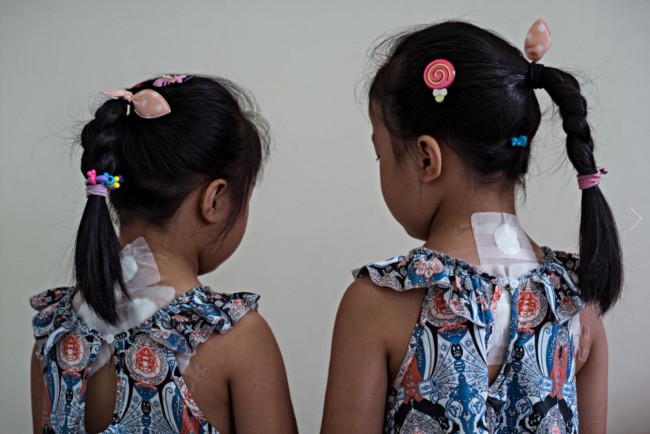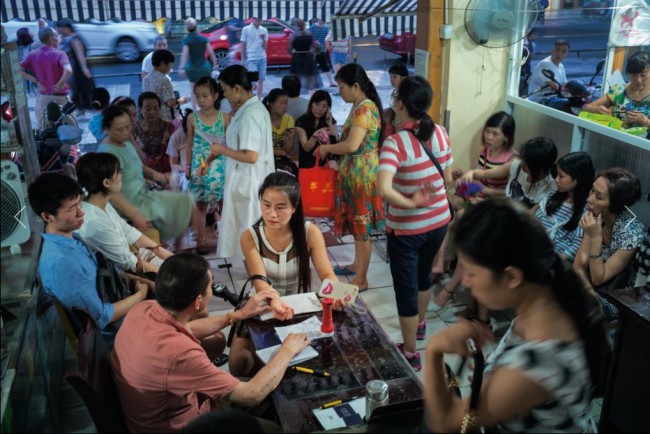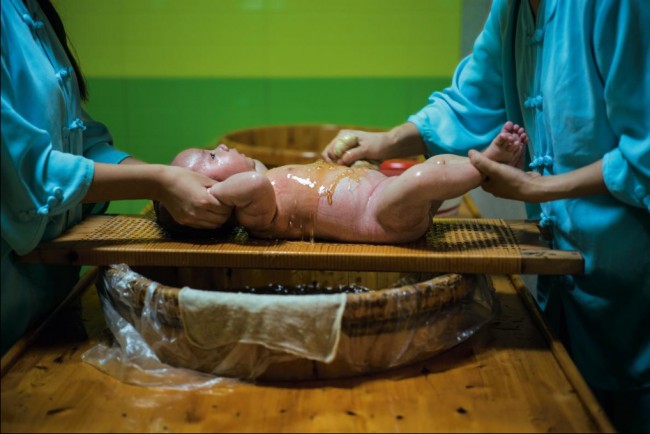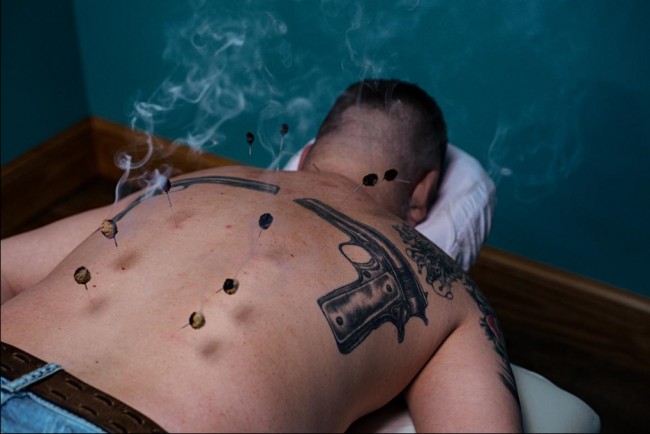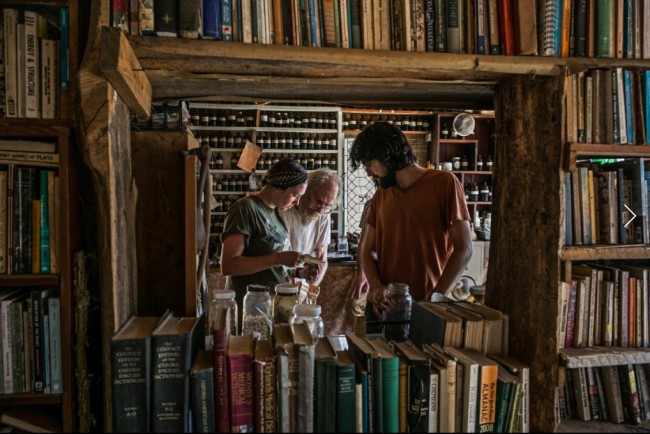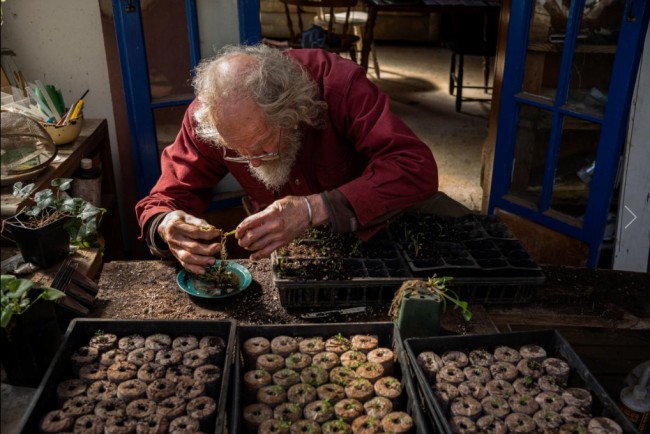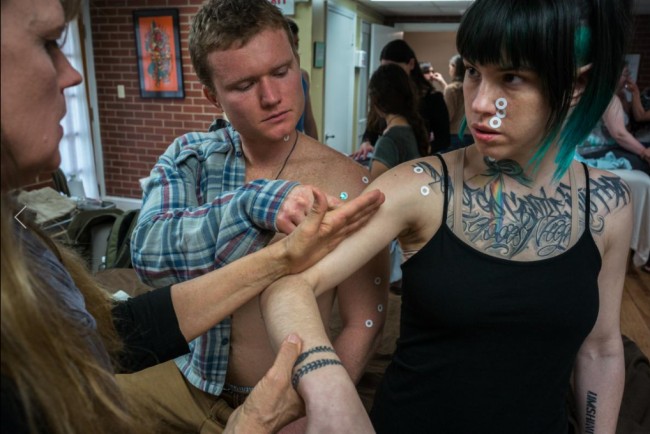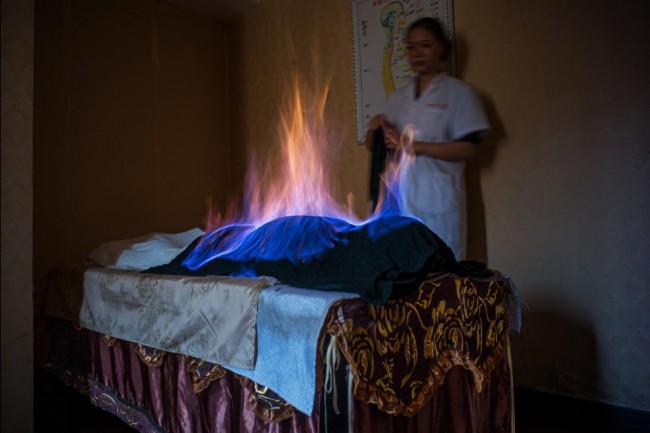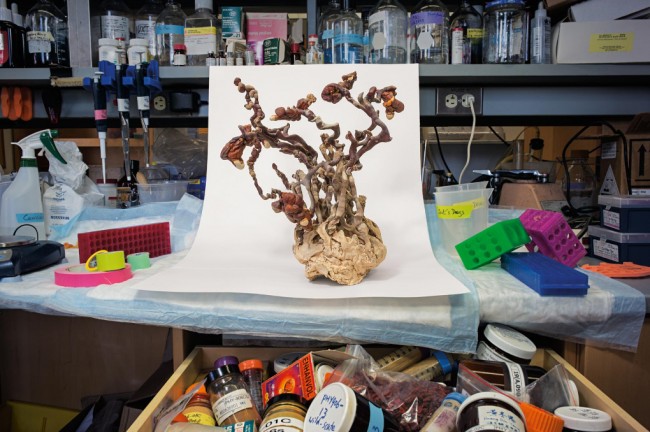동향분석
Home > 뉴스브리핑센터 > 동향분석| [동향분석] How ancient remedies are changing modern medicine (2) |
|
How ancient remedies are changing modern medicine (2) By Peter Gwin / Photographs by Fritz Hoffmann Traditional Chinese ways of healing
At the Chengdu University of Traditional Chinese Medicine hospital, twin sisters Zheng Yue and Zheng Hao wear medicinal patches that contain a formula of herbal medicine used as a seasonal treatment to expel heat from the body during summer.
A traditional practitioner at a clinic in Chengdu checks a patient’s pulse as others wait. Next he will inspect the tongue and examine other body parts to identify symptoms, then prescribe a treatment to bring the body into balance and help it fight off illness.
Two-month-old Ren Yanyu in Chengdu is bathed in an herbal solution meant to detoxify and cool the body during the humid summer months. The treatment is part of the Chinese philosophy of maintaining the body’s overall well-being, not just treating ailments after they’ve surfaced.
At a clinic in Beckley, West Virginia, Jeff Hendricks receives acupuncture and a plant-burning technique called moxibustion to ease pain related to four years of military service. He suffers from a brain injury, bulging disks in his neck, bone spurs, headaches, numbness in his hands, and PTSD. The VA-approved treatment reduces the need for conventional drugs. After analyzing tumors in mice that were given the formula, Peikwen says, researchers noticed a significant increase in tumor-eating macrophages—white blood cells that gobble up cancer cells. The way the herbs interact appears to be the key. “That’s really where the frontier lies,” Peikwen says. “PHY906 is a cocktail of chemicals—not unlike the drug cocktails that finally proved effective for AIDS patients. We’re just unraveling the original formula and putting it back together in a modern, scientifically based therapy.” To date PHY906 has been used in eight human trials alongside different chemotherapy drugs and radiation to treat colorectal, liver, and pancreatic cancers, Peikwen tells the audience. “We are hopeful that PHY906 will become the first FDA-approved, multi-herb drug.” Afterward, several pharmaceutical reps pull him aside to speak privately. Peikwen and I hurtle into the heart of China on a modern bullet train. The ride is remarkably smooth, as if we’re floating above the track. Meanwhile, ancient China flashes by, an endless patchwork of farms under a gray winter sky. Peikwen agreed to let me visit the source of the herbs if I wouldn’t reveal the full names of the farmers or their locations, which he and his father, along with their partner Sun Ten, a Taiwanese pharmaceutical herb company, consider proprietary information. I can say this part of China looks like a version of Kansas—tabletop flat with neatly furrowed fields as far as I can see. But among the wheat, rice, and rapeseed are plots of herbs tended by thousands of farmers. As the global appetite for herbal remedies has grown, Chinese farmers have devoted increasing amounts of acreage to hundreds of medicinal plant species. In 2017 the nation’s medicinal herb-growing industry generated about $25 billion. But before you quit your job to farm herbs, here’s the problem: Producing medicine-grade herbs is extraordinarily difficult. The chemical potency of each herb can vary greatly, depending on many factors—minerals in the soil, the altitude at which it’s grown, when and how it’s harvested. And then there’s the matter of subspecies that may look exactly alike but have slightly different chemical compositions. Ask a pot smoker about the difference in potency from one marijuana strain to the next, and you’ll get an earful. Or ask a coffee grower: Arabica beans grown in one part of Ethiopia can have six times as much caffeine as those grown in another part of the country. And depending on how they’re ground and brewed, the same beans can yield different caffeine amounts. These complications are part of the reason that the FDA has approved only two herbal prescription drugs—a genital wart treatment made from green tea extract and a diarrhea medicine made from the sap of the South American dragon’s blood tree. Both those drugs contain a single herb, but PHY906 is composed of four, which means more variables must be controlled to make a consistent product. “This complexity is partly why there aren’t any FDA-approved, multi-herb drugs,” Peikwen says. When we finally get to one of the fields that yielded PHY906, I’m frankly a little disappointed. Except for the fact that the farmer, Chen, is speaking Mandarin, he might as well have been from Kansas. Wearing muddy boots, a heavy parka, and a baseball cap, he pulls out his iPhone and asks Siri to translate the Chinese name of his crop into English. “Peony,” she answers. As we tour his fields of peony and skullcap bushes, he explains his crop rotations, soil and water analyses, planting and harvesting protocols. Before shipping the herbs, he says, technicians from Sun Ten perform multiple tests to reconfirm the species; screen for microorganisms, toxins, and heavy metals; and complete other quality checks. “You’ve heard of farm to table,” Peikwen says. “The idea here is farm to bedside.” I tell him that sounds like a marketing slogan. But it’s true, says Chen. “Most companies making herbal remedies don’t get them from farms like this. They get them from Bozhou.”
Framed by his library, which includes books on gardening and herbal medicine, Joe Hollis, a master gardener, instructs two of his apprentices, Michaela Shaw and David Hall, as they fill a traditional Chinese herbal prescription.
With the arrival of spring at Mountain Gardens in Burnsville, North Carolina, master gardener Hollis separates seedlings and plants them in starter soil at the potting bench in his home. Hollis’s nationally recognized array of Chinese herbs serves local practitioners of traditional medicine.
During a class on acupuncture at Daoist Traditions College of Chinese Medical Arts in Asheville, North Carolina, instructor Susan Lorentzen (left) shows first-year student Rory Hiltbrand (center) and classmate Ashley Smith (right) specific points on the body to insert needles, depending on a patient’s symptoms. If you buy Chinese herbs on Amazon, there’s a decent chance that they passed through the eastern city of Bozhou, the center of the Chinese medicine universe. Every day 10,000 traders sell thousands of different products to 30,000 buyers from all over Southeast Asia, all of them jammed in a colossal structure resembling a domed football stadium. The morning I visit Bozhou, the market is already a raucous hive of commerce. I zigzag up and down endless aisles, one cavernous room after another, each chock-full of barrels, sacks, pallets, and wheelbarrows heaped with wares derived from what appears to be nearly every plant, mineral, and creature on the planet, including exotic items like deer penises, human placentas, water buffalo bones, and dried seahorses. A section the size of a grocery store is devoted to the cure-all ginseng root—red and white, wild and cultivated, fresh and dried, ranging in price from a few dollars to several thousand. In the insect section, I stop counting the different centipede species at 11. I’ve come here to see the source of most Chinese herbal drugs marketed around the world. You can find seemingly every ingredient here, but you’d have little clue how it was grown or where. Sure enough, I easily find all four ingredients for PHY906—but all are sold by resellers who know little of the herbs’ origins. Before I leave the market, one ingredient catches my eye. In a section near deer antler velvet, I see a glass case with a row of bottles containing yellowish liquid. I ask the vendor what it is, and he gets his neighbor to translate. “Take from bear,” the man says. “Very good.”
In a fire treatment session in Chengdu, an alcohol-soaked cloth is draped over a patient and set alight to warm the skin and open the pores; an herb-infused oil is then applied. The therapy aims to treat joint pain and other ailments, but research has yet to prove such claims. Paul Iaizzo loves bears. An avid outdoorsman who grew up in Minnesota, he has long been fascinated by the animals, which roam the state’s forests. As head of the University of Minnesota’s Visible Heart Lab, he’s especially interested in their unique physiology and has teamed up with the state’s Department of Natural Resources to study how they hibernate. Tall and lean, with a mane of silver hair, Iaizzo ticks off a list of mysteries related to bears, which spend up to six months completely inactive yet suffer no ill effects. Their breathing slows to as few as two breaths a minute. Their temperature drops by 10 percent, which would cause hypothermia in a human. They regularly lose more than half of their body fat but no muscle. Their hearts can pause for 20 seconds, but their blood never clots. Humans risk deadly clots if their hearts pause for only a few seconds. And yet if a predator approaches, a bear can wake up to defend its den. “And its heart suffers no damage,” Iaizzo says. The earliest mention of bear bile in Chinese literature turns up in a 40-volume treatise from the eighth century called The Medical Secrets of an Official. It prescribes bear bile for liver problems, as well as fever, hemorrhoids, and other ailments. In 1902 a Swedish scientist isolated one of the chemicals in bear bile, later named ursodeoxycholic acid, and it’s now used in drugs for liver diseases and gallstones. But Iaizzo and other researchers believe there are many more secrets to be revealed from bear bile, which is produced by the liver, stored in the gallbladder, and secreted as hormones into the bloodstream. They are taking aim at a range of therapies, including treatments for muscular dystrophy and for bedridden patients who can lose half of their muscle mass in three weeks. He’s identified three classes of bile components that likely trigger hibernation and may help heart patients—fatty acids, bile acids, and delta opioids. During the procedure on the pig, he injected a synthetic mixture of these into the protective membrane around the beating heart to coat the organ for an hour before he removed it.
Cheng’s team grew this Ganoderma tsugae fungus in the lab. The species has been found to shrink colorectal tumors in animals. “The Chinese have used herbs for centuries,” Cheng says. “The challenge to scientists is to find out which formulas work, and why.” Over hundreds of experiments, he’s seen pig hearts—which are very similar to human hearts—last up to twice as long as they usually do outside the body. There are many possible applications for humans. Most notably, hearts from donors could be kept viable longer and, once inside a recipient, could be restarted faster. Currently, a heart must be transplanted within six hours or less. In the U.S., 300 people die every year waiting for hearts. “If we could preserve a heart for 24 hours, we could get it anywhere in the world,” Iaizzo says. “And that could vastly increase the number of available organs. That would be a game changer.” I ask him whether the Chinese practice of drinking bear bile could really bestow any health benefits. “It could,” Iaizzo says, noting the chemicals would enter the bloodstream and move through the heart and other organs. He doesn’t condone farming bears for their bile, emphasizing that the chemicals can be synthesized, but the science is the science. And though the ancient Chinese didn’t understand how bear bile helped humans, they observed that it did. As I hold the pig heart, I can feel its rhythm slowing. It finally stops. The pig died hours ago, and now its heart has stopped too. Its color seems to dim—like a mahi-mahi that loses its lightning yellow glow as it dies in the hands of a fisherman. I wonder if whatever is now gone is what the ancient Chinese meant by qi. I think of the moment in the hospital when I was holding my father’s hand and felt his pulse finally stop. I’m suddenly aware of my own heart, flexing and lurching inside my rib cage, and wonder about its other mysteries. |








